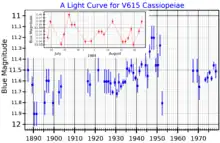| Observation data Epoch J2000 Equinox J2000 | |
|---|---|
| Constellation | Cassiopeia |
| Right ascension | 02h 40m 31.6643s[1] |
| Declination | +61° 13′ 45.592″[1] |
| Apparent magnitude (V) | 10.61–10.83[2] |
| Characteristics | |
| Spectral type | B0Ve[3] |
| U−B color index | −0.34[4] |
| B−V color index | +0.86[4] |
| Variable type | High-mass X-ray binary[2] |
| Astrometry | |
| Radial velocity (Rv) | −41.41 km/s |
| Proper motion (μ) | RA: 0.27[5] mas/yr Dec.: 2.38[5] mas/yr |
| Parallax (π) | 0.45 ± 0.23 mas[1] |
| Distance | approx. 7,000 ly (approx. 2,000 pc) |
| Other designations | |
| Database references | |
| SIMBAD | data |
LS I +61 303 is a microquasar, a binary system containing a massive star and a compact object. The compact object is a pulsar and the system is around 7,000 light-years away.
Discovery
LS I +61 303 is an 11th-magnitude star that was recognised as a luminous object and catalogued as an OB star in 1959.[6] It was included in the Hipparcos survey as HIP 12469 and had its parallax measured at 5.65±2.28 milliarcseconds (mas), revised to −0.29±2.99 mas in the new reduction.[5] The first Gaia data release gave a parallax of 0.45±0.23 mas.[1]
The galactic radio source GT 0236+610 was found at the same position as LS I +61 303. A gamma-ray source 2CG 135+01 was found within a degree of its position, and the MAGIC telescope confirmed that LS I +61 303 was the source of the gamma rays. Periodic X-ray outbursts also occur.[7]
Binary system

LS I +61 303 shows the spectrum of a Be star, a B0 main sequence star with disk that produces emission lines in its spectrum. Variations in its radial velocity show that it is in orbit with an unseen compact object having a mass between 1 and 4 M☉. The pair orbit every 26.496 days.[7] Although the uncertain mass of the compact object would allow it to be a neutron star, it is thought likely to be a black hole.[10] In March 2022, a period of ~0.27 s was reported to be detected in observations using the FAST telescope, confirming the neutron star nature of the compact object. This promotes the possibility that the system is indeed the first one detected containing a pulsar with magnetar behavior in it.[11][12]
Variability
LS I +61 303 varies slightly at optical wavelengths, but measurements going back to 1887 show no obvious period. It also shows regular X-ray outbursts coinciding with its orbital period, and strong radio variability.[8] It was given the variable star designation V615 Cassiopeiae.[2]
Microquasar
LS I +61 303 emits HE and VHE (High Energy and Very High Energy) gamma rays.[3][7] It is only one of several known star systems that produce such energetic rays. Other such systems are PSR B1259–63, LS 5039 and HESS J0632+057.
References
- 1 2 3 4 Gaia Collaboration (2016). "Gaia Data Release 1". Astronomy & Astrophysics. 595: A2. arXiv:1609.04172. Bibcode:2016A&A...595A...2G. doi:10.1051/0004-6361/201629512. S2CID 1828208.
- 1 2 3 Samus, N. N.; Durlevich, O. V.; et al. (2009). "VizieR Online Data Catalog: General Catalogue of Variable Stars (Samus+ 2007-2013)". VizieR On-line Data Catalog: B/gcvs. Originally Published in: 2009yCat....102025S. 1. Bibcode:2009yCat....102025S.
- 1 2 Paredes, Josep M; Ribó, Marc; Bosch-Ramon, Valentí; West, Jennifer R; Butt, Yousaf M; Torres, Diego F; Martí, Josep (2007). "Chandra Observations of the Gamma-Ray Binary LS I +61 303: Extended X-Ray Structure?". The Astrophysical Journal Letters. 664 (1): L39–L42. arXiv:0706.0877. Bibcode:2007ApJ...664L..39P. doi:10.1086/520674. S2CID 9974663.
- 1 2 Reig, P; Fabregat, J (2015). "Long-term variability of high-mass X-ray binaries. I. Photometry". Astronomy & Astrophysics. 574: A33. arXiv:1411.7163. Bibcode:2015A&A...574A..33R. doi:10.1051/0004-6361/201425008. S2CID 119183277.
- 1 2 3 van Leeuwen, F.; et al. (2007). "Validation of the new Hipparcos reduction". Astronomy and Astrophysics. 474 (2): 653–664. arXiv:0708.1752. Bibcode:2007A&A...474..653V. doi:10.1051/0004-6361:20078357. S2CID 18759600.
- ↑ Hardorp, J; Rohlfs, K; Slettebak, A; Stock, J (1959). "Luminous stars in the Northern Milky Way. Part I". Hamburger Sternw. 01. Bibcode:1959LS....C01....0H.
- 1 2 3 Albert, J; et al. (2006). "Variable Very-High-Energy Gamma-Ray Emission from the Microquasar LS I +61 303". Science. 312 (5781): 1771–3. arXiv:astro-ph/0605549. Bibcode:2006Sci...312.1771A. doi:10.1126/science.1128177. PMID 16709745. S2CID 20981239.
- 1 2 Gregory, P. C; Taylor, A. R; Crampton, D; Hutchings, J. B; Hjellming, R. M; Hogg, D; Hvatum, H; Gottlieb, E. W; Feldman, P. A; Kwok, S (1979). "The radio, optical, X-ray, gamma-ray star LSI +61 deg 303". Astronomical Journal. 84: 1030. Bibcode:1979AJ.....84.1030G. doi:10.1086/112508.
- ↑ Lipunova, N. A. (February 1988). "Search for Optical Variability of the Brightness of the Source LSI+61DEG303 – a Star with Regular Bursts of Radio Emission". Soviet Astronomy. 32 (1): 52. Bibcode:1988SvA....32...52L.
- ↑ Massi, M; Migliari, S; Chernyakova, M (2017). "The black hole candidate LS I +61°0303". Monthly Notices of the Royal Astronomical Society. 468 (3): 3689. arXiv:1704.01335. Bibcode:2017MNRAS.468.3689M. doi:10.1093/mnras/stx778. S2CID 118894005.
- ↑ Weng, Shan-Shan; Qian, Lei; Wang, Bo-Jun; Torres, D. F.; Papitto, A.; Jiang, Peng; Xu, Renxin; Li, Jian; Yan, Jing-Zhi; Liu, Qing-Zhong; Ge, Ming-Yu (2022-03-17). "Radio pulsations from a neutron star within the gamma-ray binary LS I +61° 303". Nature Astronomy. 6 (6): 698–702. arXiv:2203.09423. Bibcode:2022NatAs...6..698W. doi:10.1038/s41550-022-01630-1. ISSN 2397-3366. S2CID 247538703.
- ↑ "Radio pulsation from the system LS I 61 303 detected, after decades of search". www.ice.csic.es (in European Spanish). Retrieved 2022-03-18.
External links
- Astronomers Discovery Very High Energy Gamma-ray Emission From Microquasar (ScienceDaily) May 19, 2006
- MAGIC – Major Atmospheric Gamma Imaging Cerenkov Telescope
- MAGIC Telescope home page
- TeV gamma ray source catalog home page